Taking Problems as Methods: A New Framework for Understanding Chain Abstraction
Author: Lydia Wu, Mint Ventures

If you were confused when first encountering the concept of "chain abstraction," you are not alone.
------ It seems important, there are many projects, a lot of funding, and everyone claims to be the standard… but you don't know what it's useful for. Is "chain abstraction" just another buzzword on the Web3 new concept assembly line?
This article will start from the concept, return to the fundamental questions, hoping to scoop pearls from the sea of emptiness.
TL; DR:
- The purpose of abstraction is to hide complexity; the level of abstraction in the Web3 context is often higher than in Web2 (thus more difficult).
- Modularity lowers the threshold for building public chains, while chain abstraction includes a restructuring of public chain relationships and improvements in user/developer experience.
- Cross-chain asset transfer, cross-chain communication, interoperability, and chain abstraction analysis: a subset of concepts centered around coordinating state modifications (transactions) across different chains (but often filled with gray areas in practical use).
- Intent-based chain abstraction solutions have become a popular architecture, and many component-type products may gradually piece together the final form of chain abstraction.
- The current industry discussions and constructions around chain abstraction have not yet broken the superstition of infra-centricity; the establishment of chain abstraction as a real problem is inseparable from on-chain activity, modularity progress, and the influx of new users and developers.
- The future of chain abstraction is not a smooth path; it needs to consider the impact on long-tail public chains and the exploration of non-DeFi applications.
What is the problem of chain abstraction?
- Is chain abstraction a real problem?
- If so, what category does it belong to among many problems?
- What are the differences between cross-chain, interoperability, and chain abstraction?
Is chain abstraction a real problem?
------ Not necessarily. The establishment of a problem requires context; imagine asking someone from 500 years ago about their views on the energy crisis.
So where does our discussion of chain abstraction come from?
Different people may provide answers that include several keywords: Ethereum roadmap, modularity, intent, mass adoption… Currently, the most explanatory viewpoint may be: Chain abstraction is the second half of modularity.
To understand this viewpoint, it is necessary to clarify the definition of chain abstraction.
In computer science, "abstraction" refers to the process of separating high-level operations and concepts from backend processes, with the goal of simplifying understanding by hiding complexity. For example, most Web2 users only need to know about browsers and ChatGPT, and they can be completely unaware of the abstracted content or even the abstract concepts themselves.
Similarly:
- Account abstraction: Achieving seamless accounts by hiding internal information such as blockchain account addresses, private keys, and mnemonic phrases.
- Chain abstraction: Achieving seamless chains by hiding internal information such as consensus mechanisms, gas fees, and native tokens of various chains.
In traditional software development, abstraction and modularity are a set of closely related important concepts. Abstraction defines the levels and architecture of a system, while modularity is the way to implement that architecture. Specifically, each module represents an abstraction level, and the interactions between modules hide their internal complexity, facilitating code extension, reuse, and maintenance. Without abstraction, the boundaries between modules would become complex and difficult to manage.
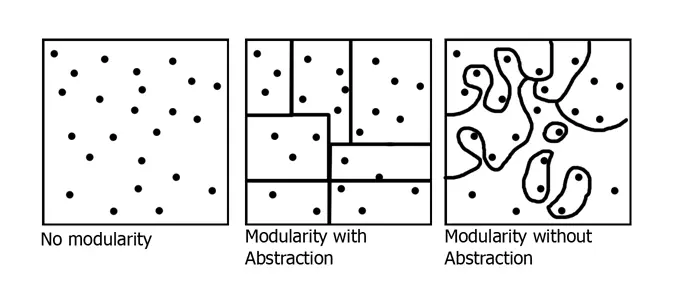 Source: https://web.cs.ucla.edu/classes/winter12/cs111/scribe/3a/
Source: https://web.cs.ucla.edu/classes/winter12/cs111/scribe/3a/
It is worth noting that Web2 typically performs abstraction and modularity within closed or partially closed ecosystems, with abstraction levels concentrated within a single platform or application, in a relatively controlled environment, usually not needing to solve cross-platform or cross-system compatibility issues. However, in the Web3 context, the relationship between modularity and abstraction is more complex due to the pursuit of decentralization and open ecosystems.
Currently, while modularity helps solve the abstraction problems within individual public chains and lowers the threshold for building public chains, the abstraction of user/developer experience in a multi-chain landscape is an area that modularity has not fully covered. There is a noticeable island effect between different public chains and ecosystems, specifically reflected in liquidity, and the dispersion of developers and users. The proposal of chain abstraction includes a restructuring of public chain relationships to achieve connection, integration, and compatibility between multiple chains, which can be corroborated by the article released by Near in January this year.
We can consider the urgency of chain abstraction as a real problem closely related to the development of the following conditions:
- On-chain activity: Whether more dAPPs bring more user on-chain active behavior.
- Progress of modular blockchains: Whether more active on-chain behavior drives the construction of more rollups and app chains.
- Barriers to entry for new users and developers: To what extent does the current blockchain environment hinder the influx of new users and developers (referring to wear and tear in an upward trend, rather than stagnation).
What category does chain abstraction belong to among many problems?
Chain abstraction itself is an abstract concept, and the narrative level within Web3 is also relatively high-dimensional, which may partly explain why chain abstraction presents a comprehensive and even perplexing appearance. Specifically, it is not a solution, but a guiding philosophy.
Another example is today's Bitcoin, which, after experiencing several halvings, rapid rises and falls, and the landing of ETFs, has become more than just a technical solution or asset class; it has become a timeless ideological system and industry totem, representing a series of core values of cryptocurrency, and it will continue to guide innovation and development in the industry for the foreseeable future.
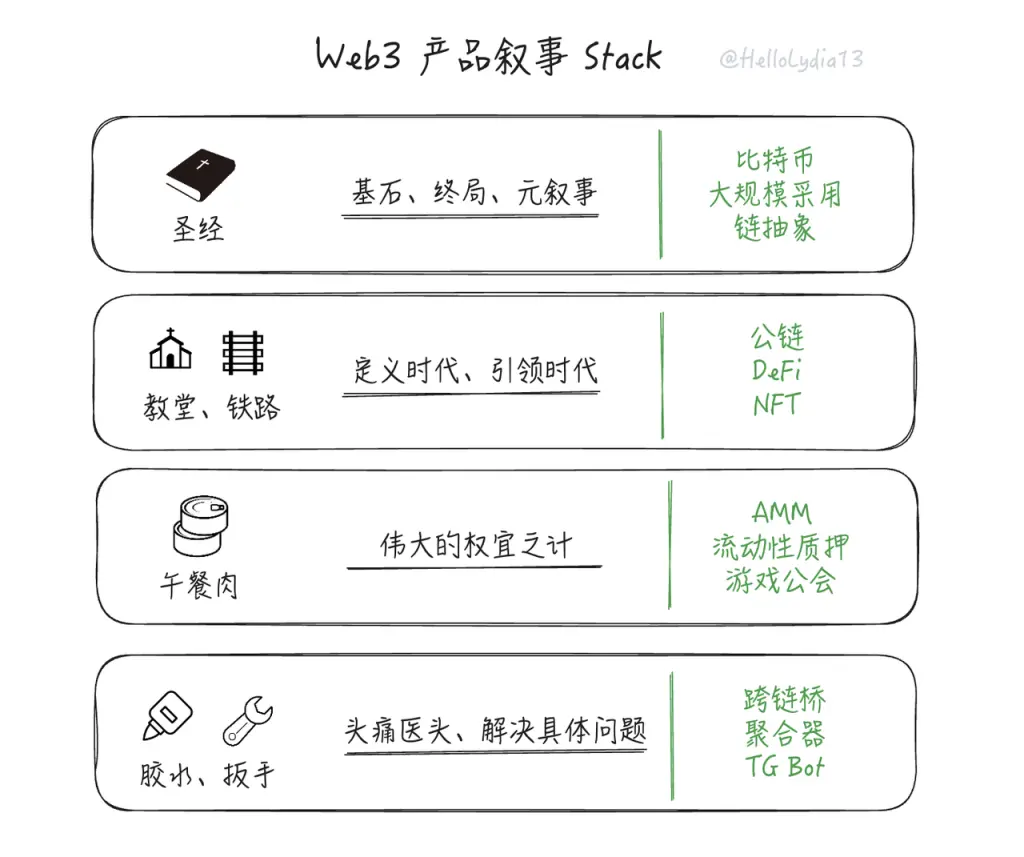
What are the differences and connections between cross-chain, interoperability, and chain abstraction?
We can also understand cross-chain, interoperability, and chain abstraction along a spectrum from concrete to abstract. In terms of form, they are a subset of concepts centered around coordinating state modifications (transactions) across different chains, but in practical use, they are often filled with gray areas.
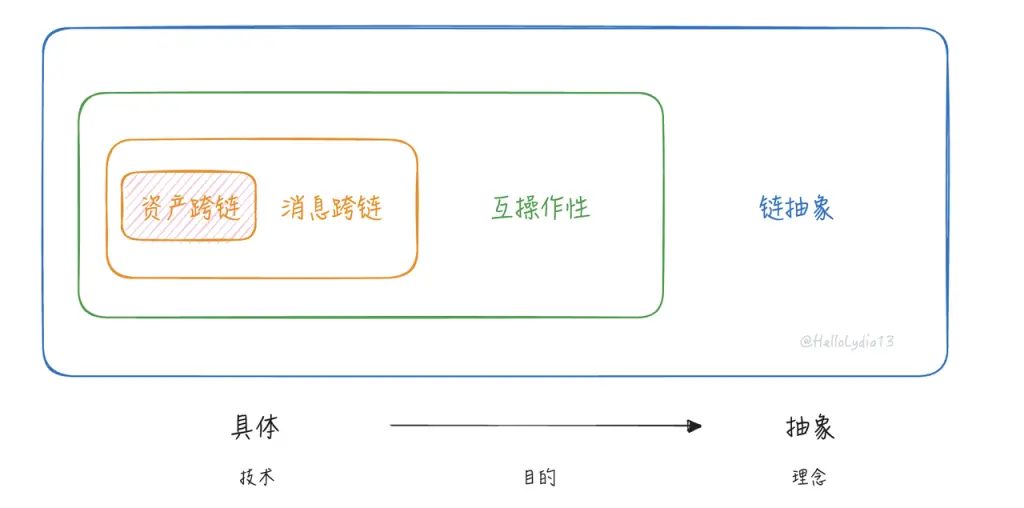
We can roughly divide cross-chain related applications and protocols into two categories:
- Cross-chain asset transfer: Cross-chain bridges, cross-chain AMMs, cross-chain aggregators, etc.
- Cross-chain communication: Layerzero, Wormhole, Cosmos IBC, etc.
Asset transfer is also inseparable from message passing. The messaging layer of cross-chain asset transfer applications generally consists of a set of on-chain smart contracts and state update logic, abstracting this messaging function into a general, protocol-layer solution known as cross-chain communication protocols.
Cross-chain communication protocols can handle more complex cross-chain operations, such as governance, liquidity mining, NFT transactions, token releases, game operations, etc. Interoperability protocols take this a step further, involving deeper data processing, consensus, and verification, ensuring consistency and compatibility between different blockchains from the blockchain system level. However, in practical use, these two concepts often complement each other and can be interchangeable depending on the context.
The connotation of chain abstraction includes the interoperability of blockchains, but the usage context adds a layer of user and developer experience improvement, which is closely related to the narrative of intent that has emerged in this cycle. The combination of intent and chain abstraction will be elaborated on below.
What specific problems does chain abstraction include?
- How to achieve chain abstraction?
- Why should we focus on the combination of chain abstraction and intent?
How to achieve chain abstraction?
Different projects have different understandings and entry points for chain abstraction. Here we divide them into classical school, which evolves from interoperability protocols and is closer to developer-side abstraction, and intent school, which combines emerging intent architectures and focuses more on user-side abstraction.
The classical school can be traced back to Cosmos and Polkadot, which were born long before the concept of chain abstraction. OP superchain and Polygon Agglayer, as latecomers, currently focus on liquidity aggregation and interoperability within the Ethereum L2 ecosystem. Layerzero, Wormhole, and Axelar, which originated from cross-chain communication protocols, are also expanding to more chains to attract more customer adoption, aiming to enhance their network effects.
The intent school includes L1s like Near and Particle Network, which are committed to providing comprehensive solutions for chain abstraction, as well as component-type solutions that start from solving specific problems, currently mainly represented by DeFi protocols such as UniswapX, 1inch, and Across Protocol.
Whether classical or intent school, secure and fast cross-chain interactions and friendly user experiences are at the core of the design, including but not limited to unified user interfaces, seamless cross-chain dAPPs, gas sponsorship, and management.
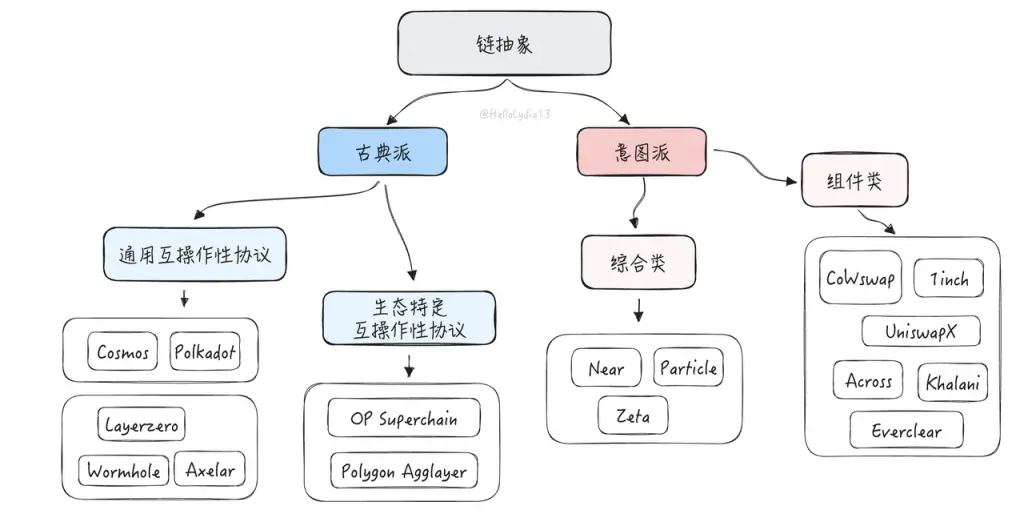
Why should we focus on the combination of chain abstraction and intent?
"Intent-based xx protocols" are emerging one after another. This section will explore the reasons and potential of this as a popular product architecture.
Similar to abstraction and modularity, intent is not a Web3 native concept. Intent recognition has existed for decades in the field of natural language processing and has been extensively studied in human-computer dialogue.
When discussing intent research in the Web3 field, one cannot overlook Paradigm's famous paper. Although similar design concepts have already been reflected in products like CoWSwap, 1inch, and Telegram Bot, the core of the intent architecture was formally proposed in this paper------users only need to specify the desired outcome without caring about the process, outsourcing the complex task process to third parties. This aligns with the user experience improvement that chain abstraction focuses on and provides a more concrete solution idea.
There are many classifications of architectures related to chain abstraction in the market, with notable ones including the CAKE framework (Chain Abstraction Key Elements) developed by Frontier Research. This framework combines intent architecture and categorizes various technologies and solutions that constitute chain abstraction into permission layer, solver layer, and settlement layer. Other frameworks have made slight adjustments based on this, such as Everclear adding a clearing function between the solver layer and the settlement layer.
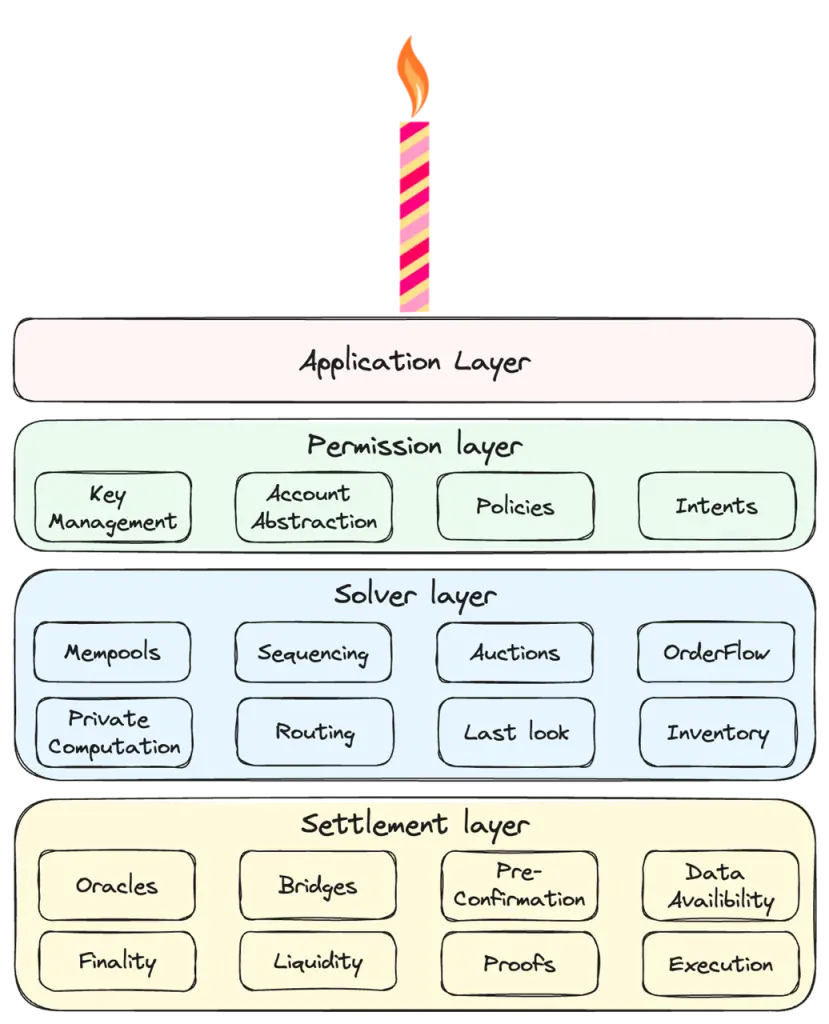 Source: Frontier Research
Source: Frontier Research
Specifically:
- Permission Layer: The core is account abstraction, serving as the user entry point for dAPPs to request intent quotes------users express intent.
- Solver Layer: Generally a third-party off-chain solver layer used to fulfill user intent ------solvers compete for orders.
- Settlement Layer: After users approve transactions, it calls oracles, cross-chain bridges, and other solutions to ensure transaction execution------users obtain expected results, and solvers receive rewards.
The solvers in the solver layer are a group of third-party off-chain entities, referred to as solvers, resolvers, searchers, fillers, takers, relayers, etc., in different protocols. Solvers typically need to stake assets as collateral to qualify for competing orders.
The process for users to use intent products is similar to filling out a limit order. In a cross-chain context, to quickly satisfy users' intents, solvers usually advance funds first and charge a certain risk fee upon settlement (this model is akin to a short-term loan, where the loan term = blockchain state synchronization time, and interest = service fee).
Comprehensive intent solutions represented by Near aim to combine the permission layer, solver layer, and settlement layer into a unified infrastructure product, currently in the early stages of concept validation, making it difficult to directly observe and evaluate its effectiveness.
In contrast, component-type intent solutions represented by cross-chain DeFi protocols have already shown significant advantages compared to traditional cross-chain models (such as Lock & Mint, Burn & Mint). As the flagship product of Across Protocol, Across Bridge's intent-based architecture allows it to achieve first-tier speed, low costs, and charging capabilities among cross-chain bridges in the EVM ecosystem, especially evident in small cross-chain scenarios.
 Different products' cross-chain speeds and costs displayed by aggregators Source: Jumper
Different products' cross-chain speeds and costs displayed by aggregators Source: Jumper 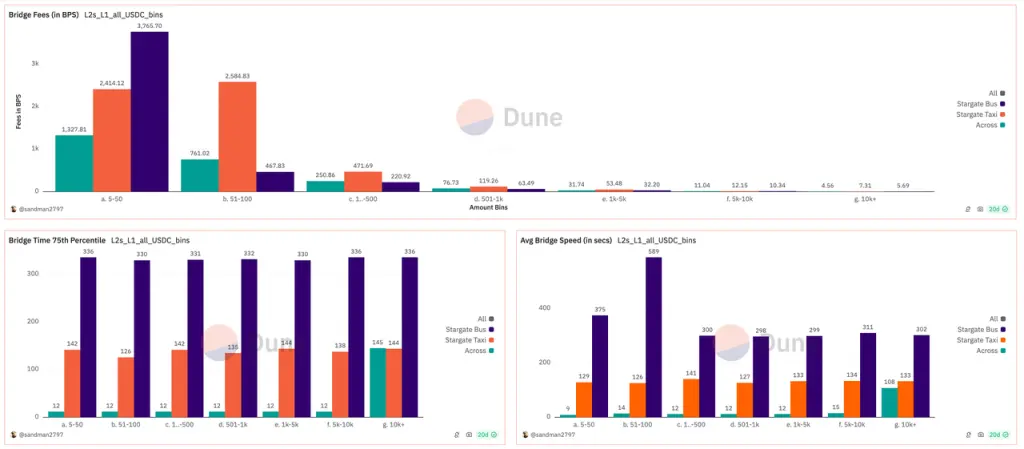 Comparison of speed and costs between Across Protocol and Stargate in L2-L1 scenarios Source: https://dune.com/sandman2797/across-vs-stargate-taxi-vs-bus-eth
Comparison of speed and costs between Across Protocol and Stargate in L2-L1 scenarios Source: https://dune.com/sandman2797/across-vs-stargate-taxi-vs-bus-eth  Across Protocol's high charging capability Source: DefiLlama
Across Protocol's high charging capability Source: DefiLlama
From the roadmap perspective, Across Protocol plans to launch a cross-chain intent settlement layer in the third phase. The ERC-7683 proposed by Uniswap Labs and Across Protocol aims to lower the entry barriers for solvers by standardizing intent expression and building a universal network for solvers. Many component-type products may gradually piece together the final form of chain abstraction.
What problems do we have in our understanding and practice of chain abstraction?
- What problems does infra-centricity bring?
- What other questions about chain abstraction are worth considering?
What problems does infra-centricity bring?
As a leading interoperability protocol, Layerzero has raised a total of $290 million, and Wormhole has raised $225 million. The tens of billions of FDV and low circulation of their tokens have made them representatives of the VC coins criticized in this cycle, undermining market confidence in the chain abstraction track.
Returning to the comic at the beginning of the article, chain abstraction projects each have their own tech stack and token standards. In a market environment lacking external increments, they are inevitably criticized as air infrastructure. The data gap before and after Layerzero's airdrop has also raised doubts about the real demand for "cross-chain communication."
 The data differences before and after Layerzero's airdrop are significant Source: https://dune.com/cryptoded/layerzero
The data differences before and after Layerzero's airdrop are significant Source: https://dune.com/cryptoded/layerzero
On the forum page for ERC-7683, in response to criticisms that cross-chain asset transfer functionality is too small, not general enough, and lacks support for many ecosystems, developers discussed the responsibilities of the ERC standard itself. Supporters of minimalist ERC believe that tool-level standards are sufficient to solve the current problems and can be combined with existing standards, facing relatively low resistance.
Considering that the design philosophy of intent architecture is largely application-oriented, "universal, full-stack, and compatible" protocol standards can sometimes become "too vague to be meaningful" or "too large to solve practical problems," leading to a rather ironic phenomenon------the chain abstraction protocols born to solve fragmentation issues themselves deliver fragmented solutions.
 Source: https://ethereum-magicians.org/t/erc-7683-cross-chain-intents-standard/19619/18
Source: https://ethereum-magicians.org/t/erc-7683-cross-chain-intents-standard/19619/18
What other questions about chain abstraction are worth considering?
- For new public chains/long-tail public chains, does chain abstraction increase the difficulty of retaining TVL (analogous to the impact of globalization on underdeveloped regions), and what impact will this have on the adoption of chain abstraction?
- A study by Variant points out that UniswapX will lead long-tail tokens to AMMs, while mainstream tokens will be filled more by off-chain solvers. Is this the future trend of DEX development? Will a global solver layer be superimposed on the global liquidity layer in the future?
- What other forms could intent-based product architectures take besides DeFi protocols?
- Will chain abstraction become a hot topic after modularity or a major bubble?














